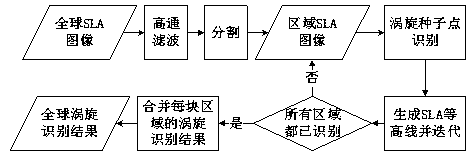Parallel-based global ocean mesoscale eddy rapid identification algorithm
A recognition algorithm and scale vortex technology, applied in computing, image data processing, instruments, etc., can solve problems such as large computational load, incorrect OW parameters, misjudgment, etc., to avoid multi-core structure, reduce the number of iterations, and improve recognition efficiency. Effect
- Summary
- Abstract
- Description
- Claims
- Application Information
AI Technical Summary
Problems solved by technology
Method used
Image
Examples
Embodiment Construction
[0021] The global ocean mesoscale vortex rapid identification method of the present invention (such as figure 2 shown), including the following steps:
[0022] (1) Perform high-pass filtering on the global sea level anomaly (SLA) data, and then divide the filtered global SLA image into several regions to obtain the SLA image data of multiple regions; the global SLA image is first processed with a radius of 5° ( latitudinal), 10° (longitudinal) high-pass filtering, and then divide the filtered image into 18 areas of the same size, and each area is divided into two parts: "inner block" ( figure 1 Middle A / B area) and "outer block" ( figure 1 Middle C area). The "outer block" is the overlapping part of two adjacent regions to avoid losing the vortex due to segmentation, so the size of the "outer block" should be larger than the maximum diameter of the mesoscale vortex, here it is set to 10°, and the size of the "inner block" is set to 50° (longitudinal) and 52° (latitudinal)....
PUM
 Login to View More
Login to View More Abstract
Description
Claims
Application Information
 Login to View More
Login to View More - Generate Ideas
- Intellectual Property
- Life Sciences
- Materials
- Tech Scout
- Unparalleled Data Quality
- Higher Quality Content
- 60% Fewer Hallucinations
Browse by: Latest US Patents, China's latest patents, Technical Efficacy Thesaurus, Application Domain, Technology Topic, Popular Technical Reports.
© 2025 PatSnap. All rights reserved.Legal|Privacy policy|Modern Slavery Act Transparency Statement|Sitemap|About US| Contact US: help@patsnap.com


